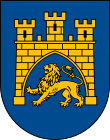
Back Ruthenischer Löwe German ルーシのライオン Japanese Рутенски лав Macedonian Lew ruski Polish Герб Галицкой Руси Russian Руський лев Ukrainian
| Ruthenian lion | |
|---|---|
 | |
| Versions | |
 | |
 | |
 | |
| Families | Rurik dynasty |
| Use | |
The Ruthenian lion (Ukrainian: Руський лев, romanized: Ruskyi lev, Polish: Lew ruski), Ukrainian lion, or Galician lion[1] is a golden lion on an azure background. The lion was featured on the historic coat of arms of the Kingdom of Galicia-Volhynia (Ruthenia), the Ruthenian Voivodeship and the Western Ukrainian People's Republic. During the revolutions in the Austrian Empire in 1848, it was restored as one of the national symbols of Ukrainians and the Ukrainian national liberation movement. Today it is featured on the coat of arms of the city of Lviv and its surrounding province, Lviv Oblast.
Usually, it was depicted as stocky, less often walking, crowned, with silver or red weapons, resting on a gold or silver rock. The oldest images appear on the seals of rulers from the fourteenth century – Yurii I of Galicia, Leo II of Galicia, Yurii II Boleslav, Vladislaus II of Opole. In the 15th–16th centuries the lion was present on the large seals of Kings Władysław II Jagiełło, Alexander Jagiellon, and Sigismund II Augustus as a symbol of Rus, along with the Polish eagle, the Lithuanian pahonia, and the Prussian eagle. Provincially it was used as the emblem of Lwów Land in the form of a lion on a rock in 15th century. In modern times it is used generally as a symbol of western Ukrainian lands, notably in Lviv and the surrounding region of Galicia. He was depicted with the emblems of Ukrainian military formations of the twentieth century – the Ukrainian Sich Riflemen (1914–1918) and the 14th SS-Volunteer Division "Galicia" (1943–1945). It is used as a coat of arms in Polish heraldry, in particular in Częstochowa and the Subcarpathian Voivodeship.
- ^ Наукові записки / Львівський історичний музей... 1995: 6.
© MMXXIII Rich X Search. We shall prevail. All rights reserved. Rich X Search